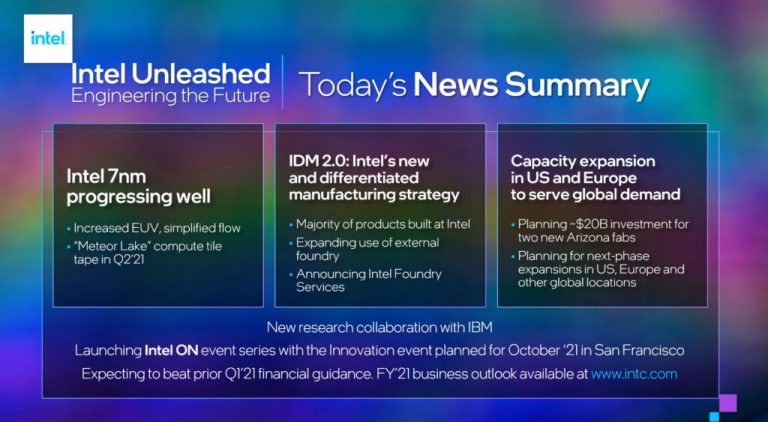Intel announced a monumental company pivot today as it unveiled its new IDM 2.0 Strategy for Manufacturing Innovation and Product Leadership.
Today, March 23, 2021, Intel announced a manufacturing expansion plan that includes a $20 billion dollar investment in the construction of two new fab plants in the state of Arizona as well as the company’s new plan to become a wholesale distributor of both x86 cores, ARM and RISC-V ecosystems by way of its new foundry strategy.
Intel CEO Pat Gelsinger covered the highlights of the company’s IDM 2.0 Strategy which were broken out into three central tenants of a business-wide effort to seemingly better position Intel for a less volatile future.
According to Gelsinger, Intel will still lean hard on its 7nm roadmap, which is apparently “progressing well.” The ability for intel to reach this milestone through mostly internal manufacturing is still one of the company’s most valued positions.
However, Intel is fully aware of a chipset world that’s rapidly growing around them and plans to expand the use of third-party foundry capacity. Intel plans to increase its third-party foundry engagements with TSMC, Samsung, and UMC to increase flexibility and increase scale while spreading out the production times for its own roadmaps.
Lastly, Intel dropped the bomb that it formed a subsidiary called Intel Foundry Services that serves as the ARM and RISC-V production unit of the company and plans to become a major distributor of those ecosystems to the US and Europe.
More specifically, Intel says, “IFS will be differentiated from other foundry offerings with a combination of leading-edge process technology and packaging, committed capacity in the U.S. and Europe, and a world-class IP portfolio for customers, including x86 cores as well as ARM and RISC-V ecosystem IPs.” Opening up itself to a wider range of ecosystem manufacturing will allow Intel to engage with chipset production for frenemies Apple and Qualcomm in the future.
IDM 2.0 is getting full backing from executives and stakeholders to the tune of a $20 billion investment to create two new fabs in Arizona, to begin with. The project is expected to create 3,000 permanent high-tech, high-wage long-term jobs, 3,000 construction jobs as well as 15,000 local long-term jobs.
When all is said and done, Intel predicts that IDM 2.0 could be a $100 billion opportunity for the company that will now look to generate longer-term revenues by enabling customers to purchase their chipset designs from Intel’s older factories.
As of now, there are no timelines being offered on the milestones of IDM 2.0, but Intel did suggest its 7-nanometer processor dubbed Meteor Lake, could be taped as soon as Q2 of 2021.



